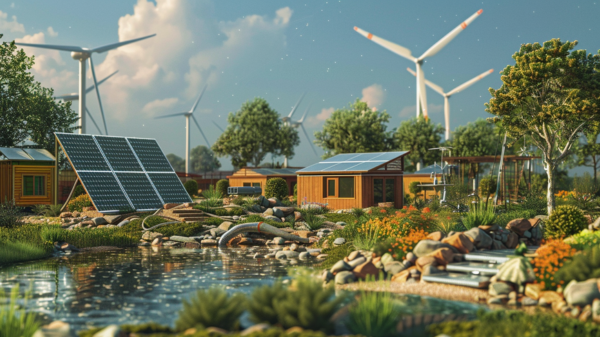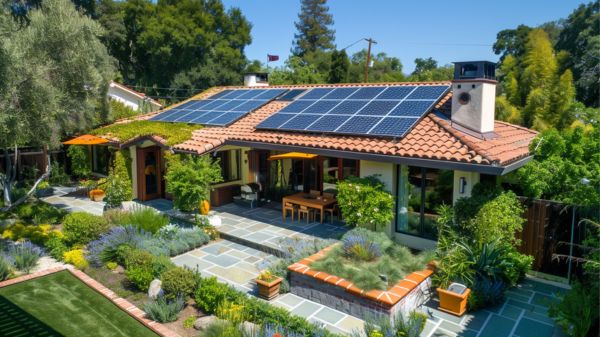Explore innovative DIY small-scale renewable energy projects like solar power banks, solar ovens, and DIY solar lighting. These innovations utilize solar technology to offer eco-friendly energy options for daily use. From constructing solar-powered garden lights to making solar trackers, there are endless possibilities to investigate.
Immerse yourself in the world of homemade solar water heaters and wireless charging systems powered by the sun. These advancements not only lower energy costs but also encourage sustainable living practices. Delve into these cutting-edge solutions to harness the power of renewable energy for a greener future.
Key Takeaways
- DIY solar projects promote sustainability and reduce energy costs.
- Solar energy innovations include portable generators and wireless charging.
- Small-scale renewable solutions offer independence and eco-friendliness.
- Solar trackers and irrigation systems optimize energy efficiency.
- Utilize readily available materials for constructing solar-powered solutions.
Solar Power Bank Project
Incorporating cutting-edge solar technology, the Solar Power Bank Project aims to revolutionize portable energy solutions for modern-day electronics users. By harnessing the power of the sun through a solar panel, this sustainable device stores energy in a battery, enabling users to charge their smartphones, tablets, and other gadgets while on the move. The concept of a solar power bank not only offers a renewable energy source but also promotes eco-friendly practices in daily life.
With a focus on convenience and environmental consciousness, solar power banks are becoming increasingly popular for outdoor enthusiasts engaging in activities such as camping, hiking, or traveling. These devices provide a crucial power source in emergencies or areas where traditional grid electricity is inaccessible.
By reducing reliance on non-renewable energy sources, solar power banks play an essential role in advocating for green living and sustainable energy practices. Embracing this innovative technology empowers individuals to embrace a more environmentally responsible lifestyle while enjoying the freedom of portable energy solutions.
Solar Oven Construction Guide
Solar oven construction involves selecting appropriate materials, following a detailed step-by-step process, and implementing tips for best performance.
Understanding the materials required, the construction steps, and performance enhancement strategies are key to successfully building and using a solar oven.
Materials Needed for Solar Oven
Utilizing readily available materials commonly found in households, constructing a solar oven involves assembling a few key components to harness the power of solar energy for cooking. Solar ovens typically require materials such as cardboard boxes for the main structure, aluminum foil to create reflective surfaces that trap solar energy, and glass or plastic coverings to retain heat.
These components work together to create a greenhouse effect within the oven, allowing temperatures to reach up to 300°F for cooking. By harnessing the sun’s energy, solar ovens offer an eco-friendly alternative to traditional cooking methods, reducing reliance on conventional fuels.
Whether used for outdoor activities, emergency preparedness, or everyday sustainable living practices, DIY solar ovens provide a practical and liberating approach to cooking.
Step-By-Step Construction Process
To start on the construction process of a solar oven, one must first focus on assembling the necessary materials and preparing for the systematic integration of components that harness solar energy for efficient cooking.
- Reflective Surface: Use materials like aluminum foil or reflective paint to create a surface that directs sunlight towards the cooking chamber.
- Insulation: Line the interior of the cooking chamber with materials like cardboard or foam to enhance heat retention.
- Transparent Cover: Install a glass or plastic cover over the cooking chamber to trap heat and create a greenhouse effect.
- Adjustable Stand: Create a stand that allows for the solar oven to be positioned at the ideal angle to maximize sunlight exposure for improved cooking efficiency.
Tips for Optimal Performance
Enhancing the efficiency of a solar oven construction project involves implementing strategic design modifications for best performance.
To optimize energy generation, consider using high-quality reflective materials like aluminum foil to concentrate solar rays inside the oven. Proper insulation with materials such as cardboard can improve heat retention and boost the oven’s temperature, making it more efficient for cooking.
Monitoring weather conditions and adjusting the oven’s position accordingly can also enhance its performance. By fine-tuning these design elements, solar ovens can reach temperatures of up to 300°F (149°C) solely using solar power.
Embracing solar technology for cooking not only offers a sustainable and eco-friendly alternative but also promotes self-reliance in outdoor activities.
DIY Solar Lighting Solutions
Harnessing the power of the sun through solar panels, DIY solar lighting solutions offer an eco-friendly and sustainable way to illuminate outdoor spaces. Here are key points to keep in mind when exploring DIY solar lighting solutions:
- Efficient Energy Conversion: Solar panels convert sunlight into electricity, which is stored in batteries to power energy-efficient LED lights, providing a reliable lighting source without relying on grid electricity.
- Cost-Effective and Easy Setup: DIY solar lighting projects are affordable, and most kits come with all the necessary components and instructions for quick and straightforward installation, making them accessible for beginners.
- Environmental Benefits: By utilizing solar power, these lighting solutions reduce energy costs and carbon footprint, contributing to a cleaner and greener environment.
- Versatile Applications: Solar-powered lights are versatile and portable, making them suitable for various outdoor activities, emergency lighting needs, or decorative purposes, offering flexibility in how and where they can be used.
Building Solar-Powered Garden Lights
Exploring the domain of sustainable outdoor lighting solutions further, the focus now shifts towards Building Solar-Powered Garden Lights, a practical and eco-conscious approach to illuminating garden spaces.
Solar-powered garden lights leverage solar energy through photovoltaic panels to charge a rechargeable battery during the day, which powers energy-efficient LED bulbs at night. This setup guarantees a constant supply of renewable energy, making these lights both cost-effective and environmentally friendly.
Incorporating a light sensor mechanism, solar garden lights automatically switch on at dusk and off at dawn, providing hassle-free operation. The installation process is straightforward, requiring no external wiring, thereby offering flexibility in adorning garden paths, flower beds, or patio areas with illumination.
By harnessing solar energy, these lights not only reduce energy bills but also contribute to curbing carbon emissions, aligning with the growing trend towards sustainable living practices.
DIY solar-powered garden lights present an engaging opportunity to interact with renewable energy technology while enhancing the visual appeal and safety of outdoor spaces. Their versatility, ease of installation, and eco-friendly nature make them a compelling choice for garden lighting solutions.
Homemade Solar Water Heater
A homemade solar water heater ingeniously utilizes sunlight to efficiently heat water for a variety of household applications. DIY enthusiasts can create these systems using simple materials and basic plumbing skills. Here are four key aspects to take into account when constructing a homemade solar water heater:
- Components: Typically, a homemade solar water heater consists of a solar collector to capture sunlight, an insulated storage tank to store the heated water, and plumbing connections to circulate the water.
- Cost-Effectiveness: DIY solar water heaters can offer a cost-effective and environmentally friendly alternative to traditional water heating systems. By harnessing the power of the sun, these systems can help reduce energy bills over time.
- Construction: Building a solar water heater can be a rewarding project that allows individuals to reduce their reliance on non-renewable energy sources. With basic materials and plumbing knowledge, constructing a homemade solar water heater becomes achievable.
- Energy Efficiency: Homemade solar water heaters contribute to energy efficiency by utilizing renewable solar power to heat water, thereby promoting sustainability and reducing the carbon footprint associated with traditional heating methods.
Crafting a Solar Tracker System
Crafting a Solar Tracker System involves designing and implementing a mechanism that adjusts the orientation of solar panels to optimize sunlight exposure for enhanced energy production efficiency. By utilizing sensors or motors, the solar tracker system can accurately follow the sun’s path, ensuring that the solar panels receive maximum sunlight throughout the day.
This dynamic adjustment capability greatly boosts energy production, with solar trackers enhancing output by 25-35% when compared to fixed solar panel installations. For small-scale renewable energy setups, integrating a solar tracker system can be a game-changer, enhancing overall effectiveness and efficiency.
Dual-axis trackers are particularly effective as they allow panels to track both the sun’s daily movements and its seasonal variations, further maximizing energy generation potential. Crafting a solar tracker system requires precision and attention to detail, but the benefits in terms of increased energy production and efficiency make it a worthwhile endeavor for those seeking to optimize their renewable energy setup.
Designing Solar-Powered Irrigation
Incorporating solar technology into irrigation systems revolutionizes agricultural water management by harnessing photovoltaic panels to power water pumps efficiently. When designing solar-powered irrigation systems, several key aspects need consideration:
- Efficient Water Pumping: Photovoltaic panels convert sunlight into electricity to power water pumps, facilitating the efficient delivery of water to crops.
- Sustainability and Cost-Effectiveness: Solar irrigation systems offer sustainable solutions for agricultural water needs while also being cost-effective in the long run.
- Reduced Dependency on Fossil Fuels: By utilizing solar energy, these systems decrease reliance on fossil fuels and grid electricity, thereby lowering operational costs for farmers.
- Water Resource Conservation: Efficient water management through solar-powered irrigation helps conserve water resources, promoting sustainability and reducing the environmental impact of agriculture.
Wireless Charging With Solar Energy
Harnessing the power of solar energy extends beyond irrigation systems, as it also enables wireless charging capabilities for devices, providing convenient and sustainable power solutions.
Wireless charging with solar energy eliminates the need for traditional power outlets, making it ideal for outdoor and off-grid applications. By utilizing photovoltaic cells, solar-powered wireless chargers can efficiently convert sunlight into electricity for charging devices.
This innovative technology promotes sustainable energy usage by reducing reliance on grid electricity for charging needs. Solar wireless charging systems offer portability, efficiency, and environmental friendliness, making them a practical solution for powering devices on the go.
With the ability to charge devices wirelessly using solar energy, individuals can enjoy the freedom of untethered power access while contributing to a more sustainable and eco-friendly lifestyle. Embracing solar energy for wireless charging not only enhances convenience but also encourages the adoption of renewable energy sources for everyday power needs.
Constructing a Portable Solar Generator
A portable solar generator comprises essential components such as solar panels, a charge controller, a battery pack, and power inverters.
The assembly process involves integrating these elements to efficiently harness solar energy and convert it into usable electricity. These generators find diverse applications in powering various devices and appliances, offering a versatile and sustainable energy solution.
Solar Generator Components
Constructing a portable solar generator involves assembling essential components such as solar panels, a charge controller, a battery, an inverter, and connecting cables into a functional system for generating and storing electricity from sunlight.
- Solar Panels: Capture sunlight and convert it into electricity.
- Charge Controller: Regulates the flow of electricity to prevent overcharging.
- Battery: Stores the electricity generated by the solar panels for later use.
- Inverter: Converts the stored direct current (DC) electricity into alternating current (AC) electricity for powering devices.
These components work together seamlessly to create a sustainable and efficient power source that can be used for various applications, providing independence and clean energy solutions.
Assembly Process Overview
The process of assembling a portable solar generator involves meticulously integrating essential components like solar panels, a charge controller, a battery pack, and an inverter to create a self-sustaining power system.
The solar panel captures sunlight and converts it into electricity, which is then stored in the battery pack for later use. A critical element, the charge controller, manages the electricity flow from the solar panel to the battery, preventing overcharging and ensuring peak performance.
Additionally, the inverter plays an essential role in converting the stored DC electricity in the battery into AC electricity, enabling the generator to power various devices efficiently. Portable solar generators offer a practical and environmentally friendly solution for accessing renewable energy in outdoor settings or during power outages.
Portable Power Applications
Efficient utilization of portable solar generators revolutionizes access to off-grid power solutions for outdoor enthusiasts and emergency preparedness.
- Portable solar generators offer a convenient off-grid power source for outdoor activities.
- Components typically include solar panels, a charge controller, a battery pack, and power outlets.
- Lightweight and compact designs make them easy to transport and set up in remote locations.
- Customizable features such as LED lights, USB ports, and AC outlets provide versatile power options.
DIY construction of portable solar generators allows for personalization based on power needs and budget, fostering hands-on learning and innovation. Embracing solar power for portable applications empowers individuals to break free from traditional energy constraints and explore the outdoors with sustainable, self-sufficient power solutions.
Frequently Asked Questions
What Are Small Scale Renewable Energy Technologies?
Small-scale renewable energy technologies encompass solar panels, wind turbines, hydro power, and biomass energy systems. These innovations provide sustainable power solutions for individual homes, businesses, and off-grid locations, contributing to reduced carbon emissions and enhanced energy independence in diverse settings.
Can You Create Your Own Renewable Energy?
Yes, individuals can create their own renewable energy through homemade solar panels, DIY wind turbines, micro hydro systems, and biofuel generators. These projects foster hands-on learning, promote sustainability, and empower individuals to contribute to a greener world.
What Is the Cheapest Way to Make Renewable Energy?
The cheapest way to make renewable energy involves utilizing DIY solar panels, homemade wind turbines, low-cost hydro power, and budget-friendly biomass systems. These options offer cost-effective solutions for individuals seeking to generate their own sustainable electricity.
What Renewable Energy Can You Use at Home?
Solar panels, wind turbines, geothermal heat pumps, hydro power, biomass boilers, and solar water heaters are renewable energy sources suitable for residential use. These innovations offer sustainable and eco-friendly alternatives to traditional energy sources for homeowners.
Conclusion
To sum up, the DIY small-scale renewable energy projects discussed in this article offer practical solutions for sustainable energy production.
From solar power banks to solar water heaters, these projects showcase the potential for individuals to harness renewable resources for everyday use.
By exploring these innovative technologies and construction guides, individuals can contribute to a more sustainable future while reducing their dependence on traditional energy sources.




